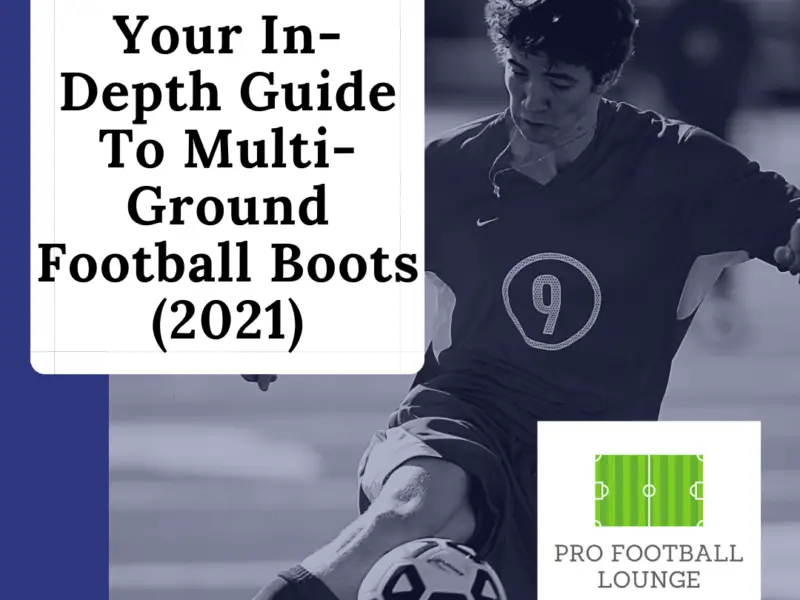If you are new to the process of buying football boots, at the start, the different soleplates for boots can be confusing.
There are a number of them, and for each one, they can typically only be worn on one surface. This includes firm ground, soft ground, artificial grass and astroturf.
In the last few years, we have seen an emergence of a new type of football boot that is multi-ground.
These are essentially just like they sound, and unlike the below surface, boots are made for multiple ones.
However, since you are here, you are probably wondering if they are any good, whether you need to buy them and of course what are they?
Table of Contents
What Exactly Are Multi-Ground Football Boots?
Multi-Ground football boots have been designed for people who play football on different surfaces.
With the increase in 3G facilities and their popularity, more people are playing their football on artificial grass and not just your typical grass pitch.
Personally, I am someone who plays on each. I will have my matchdays on a soft grass pitch and then my training sessions on a 3G.
If you have an arrangement like me, then it would seem like wearing multi-ground football boots is the best choice.
Now, if you picked up a pair of multi ground football boots, you would see a lot of similarities between them and firm ground football boots.
You may not even be able to tell the difference at first glance, and this is because they both have plastic studs which is the type on both AG and FG boots.
These are not just one of those types of boots because they have been merged to create a pair that works on both surfaces.
Is this a good thing, or is it not? By the end of this post, you will have a good idea of whether it’s for you.
What Surfaces Can You Wear Them On?
Multi-Ground football boots are made to be worn on firmer surfaces. However, while not advised too can be used on soft ground too.
The reason why it’s best to stick to firm ground surfaces is that the studs are shorter and more spaced apart, meaning you will have a hard time gripping to a wet surface.
If you end up playing an away game on a worn-out saturated pitch, you will have a hard time sticking to the pitch as you would expect with firm grounds.
So to be safe, it’s best to stick to firm grounds.
Is It Worth Buying Multi-Ground Football Boots?
Now, whenever I write guides like this, I suggest a few pairs of football boots for that ground along with it.
In this case, I won’t be, and that is because I don’t really recommend multi ground football boots, even though on paper they sound great.
You can save money, and having one pair of boots might make it simpler for you. However, my concerns lie with the soleplates.
The soleplates are optimized so that you can wear them on both surfaces. However, not to the point where it would be better than getting the boot for that surface.
For example, if you play on an artificial grass surface 70 per cent of the time and then the other 30 per cent of the time on firm grass surfaces, then going for boots that are AG and specifically designed for that surface would be the best fit.
Not just from a playing experience point of view but with the difference in grip between an AG and FG pitch, an injury point of view as well.
Now, of course, all boots go for a lot of testing before release and generally speaking, you should be safe wearing them.
But with that said, when you choose somewhat optimized football boots and ones that are fully, then the best option is quite clear.
Do Multi-Ground Football Boots Provide Value?
When it comes to cost, there are a few aspects to keep in mind.
Firstly no matter what ground of football boots you go for, you are looking at the same price.
So if you want some Nike Mercurials in the Academy (3rd out of 4 tiers) at full price is £95, that would be the same figure for AG, FG and SG.
You may come across the odd football boot, where one ground type is a few pounds more expensive which tends to be because of sales and clearances, but for the most part, they should be exactly the same price.
The other matter is do they provide value because you only have to buy one pair of boots.
Well, technically, yes, they do. If you have a set amount of money and want to get the best pair of football boots, you don’t have to split that money.
If you’re thinking of getting multiple pairs of boots and don’t have that leeway with costs, you may have to get lower-end models so that you have boots for all the grounds you’re playing on.
Choosing 1 or 2 Pairs?
If we use the above example of the Nike Mercurials for £85, you could get the one pair in the academy version.
But if you are a footballer who plays on a 3G and grass and wants to buy the AG and the FG model. Well, you are looking at double the cost, of about £170.
So instead, you could go to the lowest tier with Nike and get two pairs of club tiered football boots for around that initial mark of £85.
While in all honestly, the lower tiers are very similar to each other with Nike, it ultimately depends on your preference.
Who Makes Multi-Ground Football Boots?
The main brands that make these types of football boots include Nike, Adidas and Puma. However, the multi-ground football boots are still quite a new idea, and therefore aren’t promoted or seen as much.
Brands like the above at the moment are testing out multi-ground football boots with the lower ranges.
So if you wanted the top of the range boots that professional footballers wear, then you won’t be able to find them just yet.
With both Nike and Adidas, who have a good range of Multi-Ground football boots that includes new silos, you will only be able to see the two lowest tiered boots.
For Nike, you have Academy and Club as mentioned in the previous section, and for Adidas, it is there .3 and .4 ranges that support them.
As a result of lower end boots having the soleplate, you are looking at lower prices. You are typically looking at cheaper than £100 for a pair.
This, for me, is another reason to buy boots for each ground as that way you get the best boots available.
Conclusion
Multi-Ground football boots are completely fine in that you can pick up a pair, play a season in them over different surfaces and have a good experience with them.
For me, though, I would much prefer to have football boots that have been made to give me the best experience on a surface.
This is why I always recommend buying multiple pairs of boots if you plan on playing on various surfaces, even if that does mean buying cheaper football boots.
Now I hope that this gave you an idea of what multi-ground football boots are and if you are considering buying them that this post helped you make a decision.
If you do have any questions, then feel free to ask them to me using the section below, and I will get back to you when I next get a chance 🙂


 7 Famous Footballers Who Currently Wear Number 15
7 Famous Footballers Who Currently Wear Number 15